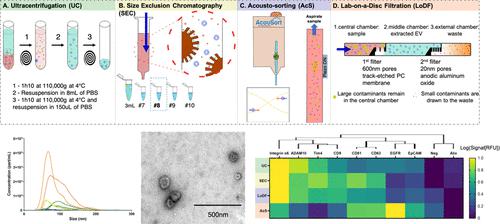Our official English website, www.x-mol.net, welcomes your feedback! (Note: you will need to create a separate account there.)
Effect of Sample Preprocessing and Size-Based Extraction Methods on the Physical and Molecular Profiles of Extracellular Vesicles
ACS Sensors ( IF 8.9 ) Pub Date : 2024-03-04 , DOI: 10.1021/acssensors.3c02070 Lucile Alexandre 1, 2, 3 , Molly L. Shen 1, 2 , Lorenna Oliveira Fernandes de Araujo 1, 2 , Johan Renault 1, 2 , Philippe DeCorwin-Martin 1, 2 , Rosalie Martel 1, 2 , Andy Ng 1, 2 , David Juncker 1, 2
ACS Sensors ( IF 8.9 ) Pub Date : 2024-03-04 , DOI: 10.1021/acssensors.3c02070 Lucile Alexandre 1, 2, 3 , Molly L. Shen 1, 2 , Lorenna Oliveira Fernandes de Araujo 1, 2 , Johan Renault 1, 2 , Philippe DeCorwin-Martin 1, 2 , Rosalie Martel 1, 2 , Andy Ng 1, 2 , David Juncker 1, 2
Affiliation

|
Extracellular vesicles (EVs) are nanometric lipid vesicles that shuttle cargo between cells. Their analysis could shed light on health and disease conditions, but EVs must first be preserved, extracted, and often preconcentrated. Here we first compare plasma preservation agents, and second, using both plasma and cell supernatant, four EV extraction methods, including (i) ultracentrifugation (UC), (ii) size-exclusion chromatography (SEC), (iii) centrifugal filtration (LoDF), and (iv) accousto-sorting (AcS). We benchmarked them by characterizing the integrity, size distribution, concentration, purity, and expression profiles for nine proteins of EVs, as well as the overall throughput, time-to-result, and cost. We found that the difference between ethylenediaminetetraacetic acid (EDTA) and citrate anticoagulants varies with the extraction method. In our hands, ultracentrifugation produced a high yield of EVs with low contamination; SEC is low-cost, fast, and easy to implement, but the purity of EVs is lower; LoDF and AcS are both compatible with process automation, small volume requirement, and rapid processing times. When using plasma, LoDF was susceptible to clogging and sample contamination, while AcS featured high purity but a lower yield of extraction. Analysis of protein profiles suggests that the extraction methods extract different subpopulations of EVs. Our study highlights the strengths and weaknesses of sample preprocessing methods, and the variability in concentration, purity, and EV expression profiles of the extracted EVs. Preanalytical parameters such as collection or preprocessing protocols must be considered as part of the entire process in order to address EV diversity and their use as clinically actionable indicators.
中文翻译:

样品预处理和基于尺寸的提取方法对细胞外囊泡物理和分子特征的影响
细胞外囊泡 (EV) 是在细胞之间运输货物的纳米脂质囊泡。他们的分析可以揭示健康和疾病状况,但细胞外囊泡必须首先保存、提取,并且通常要预先浓缩。在这里,我们首先比较血浆保存剂,其次,使用血浆和细胞上清液,四种 EV 提取方法,包括 (i) 超速离心 (UC)、(ii) 尺寸排阻色谱 (SEC)、(iii) 离心过滤 (LoDF) )和(iv)声学分类(AcS)。我们通过表征 EV 九种蛋白质的完整性、大小分布、浓度、纯度和表达谱,以及总体通量、获得结果的时间和成本来对它们进行基准测试。我们发现乙二胺四乙酸 (EDTA) 和柠檬酸盐抗凝剂之间的差异随提取方法的不同而变化。在我们手中,超速离心产生了高产量、低污染的电动汽车; SEC成本低、速度快、易于实施,但EV纯度较低; LoDF 和 AcS 都兼容过程自动化、小体积要求和快速处理时间。使用血浆时,LoDF 容易堵塞和样品污染,而 AcS 纯度高,但提取率较低。蛋白质谱分析表明,提取方法提取了不同的 EV 亚群。我们的研究强调了样品预处理方法的优点和缺点,以及提取的 EV 的浓度、纯度和 EV 表达谱的变异性。必须将收集或预处理方案等分析前参数视为整个过程的一部分,以解决 EV 多样性及其作为临床可行指标的用途。
更新日期:2024-03-04
中文翻译:

样品预处理和基于尺寸的提取方法对细胞外囊泡物理和分子特征的影响
细胞外囊泡 (EV) 是在细胞之间运输货物的纳米脂质囊泡。他们的分析可以揭示健康和疾病状况,但细胞外囊泡必须首先保存、提取,并且通常要预先浓缩。在这里,我们首先比较血浆保存剂,其次,使用血浆和细胞上清液,四种 EV 提取方法,包括 (i) 超速离心 (UC)、(ii) 尺寸排阻色谱 (SEC)、(iii) 离心过滤 (LoDF) )和(iv)声学分类(AcS)。我们通过表征 EV 九种蛋白质的完整性、大小分布、浓度、纯度和表达谱,以及总体通量、获得结果的时间和成本来对它们进行基准测试。我们发现乙二胺四乙酸 (EDTA) 和柠檬酸盐抗凝剂之间的差异随提取方法的不同而变化。在我们手中,超速离心产生了高产量、低污染的电动汽车; SEC成本低、速度快、易于实施,但EV纯度较低; LoDF 和 AcS 都兼容过程自动化、小体积要求和快速处理时间。使用血浆时,LoDF 容易堵塞和样品污染,而 AcS 纯度高,但提取率较低。蛋白质谱分析表明,提取方法提取了不同的 EV 亚群。我们的研究强调了样品预处理方法的优点和缺点,以及提取的 EV 的浓度、纯度和 EV 表达谱的变异性。必须将收集或预处理方案等分析前参数视为整个过程的一部分,以解决 EV 多样性及其作为临床可行指标的用途。



























 京公网安备 11010802027423号
京公网安备 11010802027423号